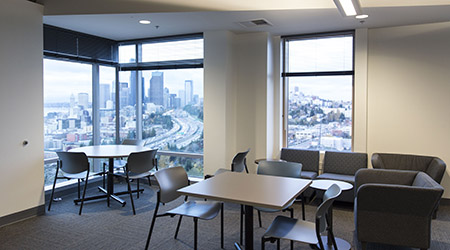The COVID-19 pandemic has prompted healthcare facility managers to revisit nearly every aspect of their buildings in light of the lessons of the last 17 months. As a result, many are researching and planning upgrades that will incorporate lessons related to updated healthy building standards, increased demands from patients and staff, and overall streamlined operations to help their organizations operate more efficiently under new financial constraints.
A new white paper from the University of Oregon’s Energy Studies in Building Lab – authored by Kevin Van Den Wymelenberg PhD, Alen Mahic, and Paul Ward — outlines the potential for luminaire level lighting control (LLLC) to revolutionize the ability of managers to monitor and respond to environmental factors that impact human health. The technology has the potential to benefit healthcare organizations through improved energy savings, asset tracking, and ventilation.
LLLC are wireless sensors embedded at the fixture level, which provide light only where it is needed, saving energy. The sensors also have multiple control capabilities that managers can leverage to support healthcare building operations, thermal comfort and visual comfort and circadian dosing. Asset tracking also can support improved situational awareness with wearable devices and smartphones in emergency events, including fires, active shooters, or pathogen exposure.
Finally, managers can integrate LLLC data with building automation and control networks to determine occupancy sensing and improve indoor air quality. This data integration can improve HVAC ventilation to reduce indoor disease transmission risk, and temperature sensors can be integrated to improve overall space thermal conditioning and occupant comfort.
Kevin Van Den Wymelenberg addressed key questions related to successfully incorporating LLLC technology into healthcare facilities:
Healthcare Facilities Today: What factors are driving the growth of LLLC technology applications?
Van Den Wymelenberg:It's a combination of the energy efficiency available, the improved attributes such as personal dimming and the ability to do some sort of asset tracking – either now or in the future – and the ease of installation. The contractors I have worked with really like this technology. Furthermore, the one-for-one fixture replacement concept is the easy button for lighting retrofits and is therefore quite common. If you do a one-for-one fixture swap with LLLC technology, you can get relatively good results, whereas with older technology, users had more problems associated with glare and overlighting. With the LLLC solutions, there is more ability for end users to modify the lighting, using dimming to overcome some of the challenges that faced historic one-for-one replacements.
HFT: What is the status of LLLC technology and products?
Van Den Wymelenberg:Lighting in general and LLLC specifically are both transforming at an incredibly rapid pace. Every time I get on the phone with manufacturers, I learn something new. It’s a mature but still rapidly developing technology. This doesn’t mean that facility managers should wait because it’s rapidly developing. You can work with LLLC now and have good results, in part because some of the innovation is on the software side. Lighting and control hardware is never going to be completely immune to major software upgrades, but there is flexibility for current hardware to accommodate control software innovations. Many LLLC systems are quite flexible, allowing for more resilient and longer-lasting installations.
HFT: In what types of facilities have LLLC systems been most popular?
Van Den Wymelenberg: We have seen a wide range of application types, but most common are offices, schools, and healthcare settings.
HFT: What are the specific benefits of LLLC to healthcare facilities related to energy savings, asset tracking and ventilation?
Van Den Wymelenberg:The asset tracking in healthcare facilities is a super-intriguing proposition. For years, design firms working on new construction projects have been seriously contemplating the value proposition of various forms of asset-tracking technologies. What I like about the asset tracking associated with LLLC is that it's integral to a system you are already buying and installing, as opposed to a separate standalone solution. The assets in hospitals could be wheelchairs, medical carts, or any sort of mobile diagnostic equipment that is moving from room to room. Keeping track of these expensive goods that move around and knowing where to find them quickly in case of an emergent event implicates both the fiscal bottom line and life safety.
As far as ventilation, researchers are exploring the value of using LLLC occupancy sensors to guide ventilation in healthcare environments. I haven't yet seen it implemented in practice, but it is eminently attainable. Typically, healthcare environments have a variable-speed air-delivery solution that modulates the amount of fresh air based upon occupant density. Hospital facility managers spend a lot of money on ventilation, from heating and cooling energy to fan energy for ventilation itself.
The real question is, will the healthcare environment ever dial back on ventilation because of the concerns of the potential implications to health? To the extent that they're above code, they could save energy by reducing ventilation to code levels when occupancy is low. The system is going to need to be robust because it's a higher-risk environment in terms of pathogen transmission. To take this step, facility managers are going to need to have a lot of confidence that the system is working well.
HFT: What are the challenges to the acceptance and implementation of LLLC technology?
Van Den Wymelenberg:The base level technology is pretty straightforward. I don't see many obstacles with the exception of it being new. I can speak with personal experience from when the University of Oregon was implementing the system here on campus. We worked with the on-staff electrical contractor. They needed to read about the solution a bit at first. They gave me a quote, and the quote was a little high. We did it anyway. As they worked through the project, the cost to install the LLLC solution was actually less than anticipated. They figured it out quickly. It’s just the newness factor for the base utilization. Then, for any sort of advanced utilization, like asset-tracking or integration with mechanical systems and ventilation, those are going to require some sort of pilot tests before facility teams will be confident in large-scale rollouts.
HFT: Who is on the in-house facilities team making decisions on LLLC technology, and who should lead the team?
Van Den Wymelenberg:To the extent that it's a one-for-one retrofit solution, it could be the facilities staff at the hospitals. Larger facilities have fairly robust facility teams. It could be an in-house or hired electrical contractor that makes those determinations or at least works with their supervisor to make those determinations.
HFT: What challenges do facility managers face in integrating LLLC applications with existing facilities technology?
Van Den Wymelenberg:It’s the interoperability between whatever software platform they currently have for their building automation system (BAS) and whatever LLLC technology they are pursuing. The starting point would be to look at your current BAS service provider or software provider and see if they have a relationship with one of the LLLC manufacturers. If they do, then take advantage of that relationship. Some of those companies are vertically integrated, meaning they sell BAS software solutions, and they manufacture LLLC software or components – or they might have relationships with somebody who has been working on the interoperability. That would be the first question.
HFT: What else should healthcare facilities managers know about LLLC technology?
Van Den Wymelenberg:The idea is that you could start with a base installation and over time look for an improvement. You have two pathways here. One approach is doing a lighting upgrade and taking advantage of whatever additional LLLC attributes might be leveraged. The other approach is that you're actually buying this LLLC solution as much for the other non-lighting attributes as for the lighting upgrades. If you're in that latter group, you're going to have to spend a little more time on the planning stage to make sure you capture full value out of the LLLC solution.

 Building Disaster Resilience Through Collaboration
Building Disaster Resilience Through Collaboration Amae Health Expands to New York City
Amae Health Expands to New York City Hospital for Special Surgery Opens Two New Facilities in New Jersey
Hospital for Special Surgery Opens Two New Facilities in New Jersey Should We Be Testing Toilet Water in Patient Restrooms?
Should We Be Testing Toilet Water in Patient Restrooms? Healthcare Union Petitions for Increased Staff Safety at HCA Florida Hospitals
Healthcare Union Petitions for Increased Staff Safety at HCA Florida Hospitals